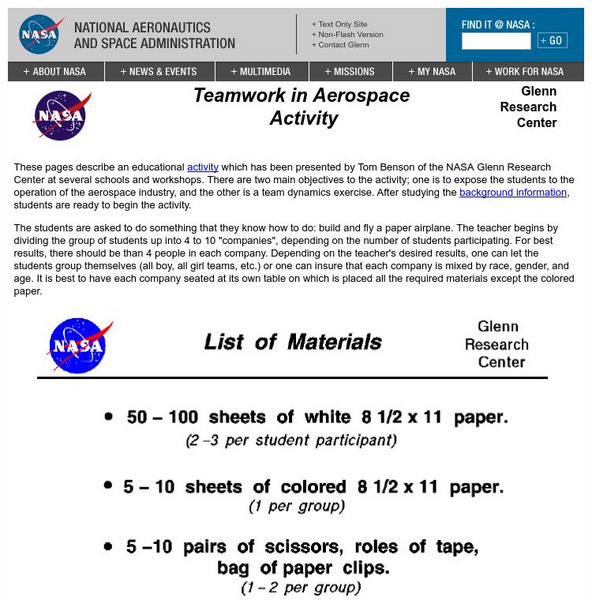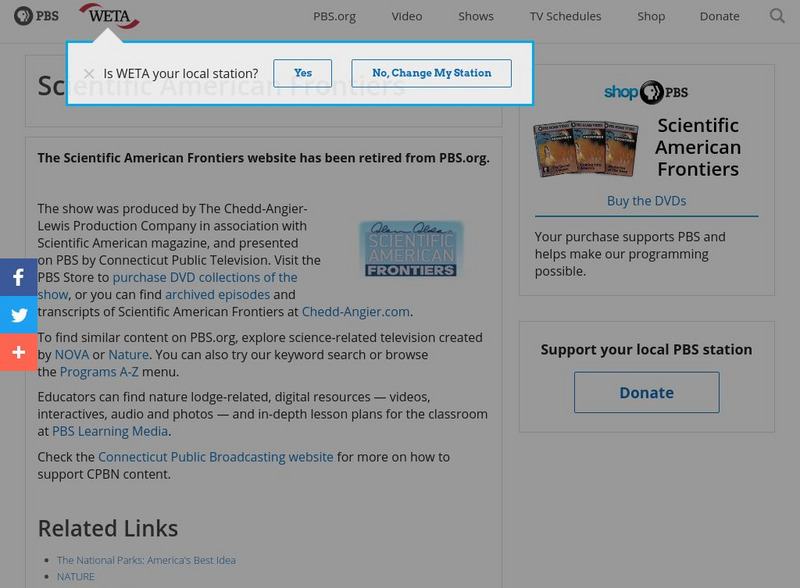TeachEngineering
Teach Engineering: Design a Parachute
After a discussion about what a parachute is and how it works, students will create a parachute using different materials that they think will work best. The students will test their designs, which will be followed by a class discussion...
TeachEngineering
Teach Engineering: Take Off With Paper Airplanes
This lesson introduces students to the art of designing an airplane through paper airplane constructions. The goal is that students will learn important aircraft design considerations and how engineers must iterate their designs to...
TeachEngineering
Teach Engineering: Are You in Control?
This lesson teaches the engineering method for testing wherein one variable is changed while the others are held constant. Young scholars compare the performance of a single paper airplane design while changing the shape, size and...
TeachEngineering
Teach Engineering: What Makes Airplanes Fly?
Learners begin to explore the idea of a force. To further their understanding of drag, gravity and weight, they conduct activities that model the behavior of parachutes and helicopters. An associated literacy activity engages the class...
TeachEngineering
Teach Engineering: Red Light, Green Light
Building upon their understanding of forces and Newton's laws of motion, students learn about the force of friction, specifically with respect to cars. They explore the friction between tires and the road to learn how it affects the...
TeachEngineering
Teach Engineering: Learn to Build a Rocket in 5 Days or Your Money Back
In this lesson, learners discover the entire process that goes into designing a rocket for any customer. In prior lessons, students learned how rockets work, but now they learn what real-world decisions engineers have to make when...
Library of Congress
Loc: Wilbur and Orville Wright Papers
Over 49,000 digitized primary documents having to do with the Wright brothers and their work with flight. A timeline of the brothers' work, a family tree, and other special presentations are offered.
The Franklin Institute
Franklin Institute Online: The Challenge of Flight
Think about the challenges that faced the Wright Brothers, then see if you can design and fly your own model aircraft. There are other sources provided to help you along the way.
Other
All Star: Airfoils
The basic theories of aeronautics are explained through several airfoil activities and animations. Click on Level 2 or 3 for an easier reading level.
Other
E Gfi: Lesson: Get a Lift
In this instructional activity, students are introduced to the four forces of flight-drag, lift, thrust, and weight-through a variety of fun-filled flight experiments. Students will "fly" for short periods and then evaluate factors that...
Maryland Science Center
Maryland Science Center: Cd Landspeeder [Pdf]
Using simple materials, create your own hovercraft in celebration of Star Wars Day, and learn what makes it hover.
Science Struck
Science Struck: Events That Led to the Invention of the Airplane
Discover the history of the first airplanes and flying machines, and how the Wright brothers constructed their first successful airplane.
Discovery Education
Discovery Education: Inventors and Inventions 2: Air and Space
After discussing important flying inventions, students explore technological design by making paper airplanes.
NASA
Nasa: Beginner's Guide to Aerodynamics
Includes exhaustive information and a wealth of activities pertaining to aerodynamics and the physics of flight.
NASA
Nasa: Flight: What Is Drag?
Understand the concept of drag and find out how it affects the movement of airplanes.
NASA
Nasa: Glenn Research Center: Teamwork in Aerospace Activity
Learn about the principles of aerospace engineering and the importance of teamwork by designing and building a paper airplane for a "fly-off" competition. Lesson plan includes introduction to team structure, activity directions, and...
MadSci Network
Mad Scientist Network: How Do Planes Fly Upside Down?
Question and answer regarding the physics principles that apply to a plane flying upside down.
Exploratorium
Exploratorium: The Science of Sports Cycling
A detailed look at the aerodynamic principles associated with cycling. Good science and even better web page design. Includes an online calculator that allows the user to calculate the aerodynamic drag and propulsive power of a bicyclist...
National Academy of Engineering
Greatest Achievements: Airplane
This page provides an overview of the history behind one of the greatest engineering innovations of all time:the airplane. There is also a timeline showing its development.
PBS
Pbs Teachers: The Frontiers Decade: Wonders of the World
Emulate the work of a naturalist by making observations of wildlife in local parks. Record field notes, including drawings, photographs and observations of behavior, on a particular animal or habitat.
Science and Mathematics Initiative for Learning Enhancement (SMILE)
Smile: Lab Activity: Aviation
This site from the Illinois Institute of Technology provides a student lab activity in which the flight of a paper airplane is investigated and studied. Designed for primary grades, but easily adaptable for junior high students.
Michigan Reach Out
Nasa Trc: Flying Wing
In this lesson plan students can make a flying wing and trouble-shoot until the wing glides smoothly.
Michigan Reach Out
Reach Out!: Making Paper Airplane Gliders
Students learn the fundamentals of aerodynamics in this hands-on exercise.
Michigan Reach Out
Nasa Trc: Maple Seed Helicopters
Students study the aerodynamic properties of a maple seed and then apply what they observe making their own flying object.























